Creating a home office in a limited space that is both stylish and functional can be a difficult task, but it's far from impossible. In my opinion, good lighting is one of the keys to making your small home office comfortable and productive. Natural light in particular can make a space feel more open and inviting, but don't rely on it alone. Incorporate a mix of lighting sources to adapt to different times of day.
In my experience, creating a functional, attractive small home office is about making the most of every inch of space. Using clever design elements, practical storage solutions, and interesting decor ideas can make a big difference to your office space.
Designing Your Small Home Office
Creating a small home office involves finding the right location, adding plenty of personal touches, and choosing the right colours or patterns for your walls. Following these steps will ensure your workspace is both functional and aesthetically appealing.
Finding the Ideal Location

Image credit: mybespokeroom.com
First, find a spot in your home that works best for you, your family, and the space you have available. An alcove or a corner of your bedroom, kitchen, or dining room could be an ideal solution. Converting part of a guest room or attic into a home office could also work perfectly.
I recommend considering a dedicated room if you have the space. This helps to keep your work and home life separate, however if this is not possible, any small space with good lighting will be a great starting point.
Incorporating Personal Touches into the Design
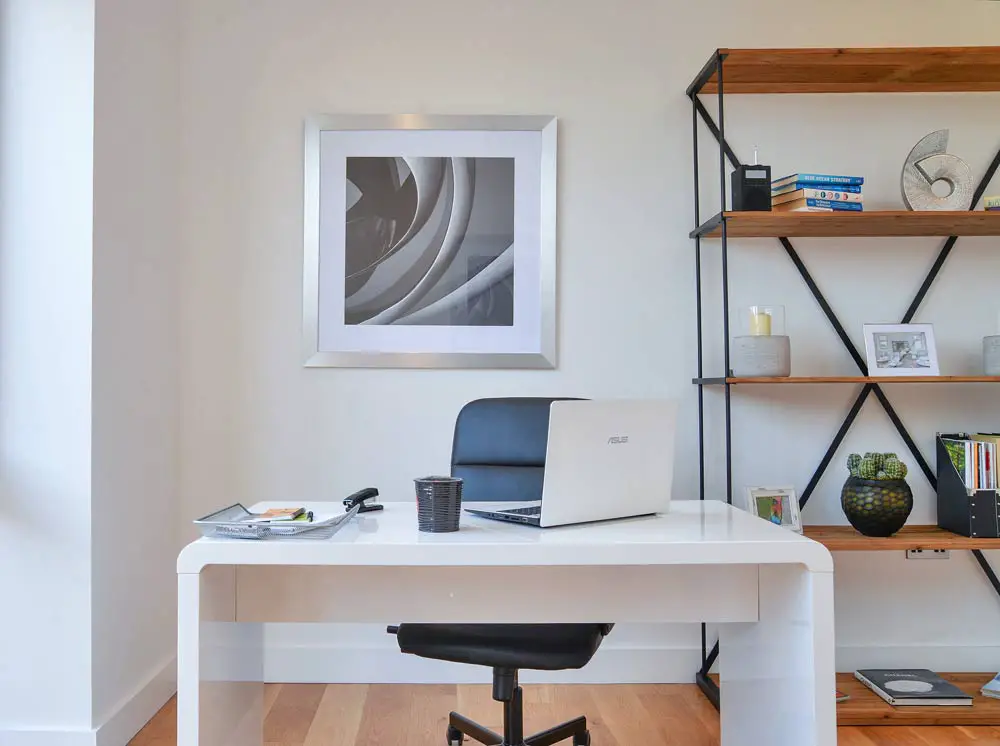
Image credit: howtosellmyhouse.co.uk
To make your workspace feel like your own, it is important to integrate personal touches and style into the home office design. I am a big believer in using personal items, such as photos, and art to decorate your walls and desk area.
You can also include your favourite colours, wallpaper designs, or wall decor pieces to make it more inviting and cosy. Personal touches will ultimately make the office a more pleasant and productive place to work, helping you stay happy and motivated.
Furniture Essentials for Small Spaces
Transforming a small home office into a functional working space is important for productivity, and with the right furniture, it’s possible to maximise both space and comfort. Let's now look into the essentials, like efficient desks, clever storage solutions, and innovative seating, to help you make the most of your limited area.
Choosing a Desk for Maximum Efficiency

Image credit: alloffice.co.za
A desk is the centrepiece of any home office. In small spaces, it's crucial to select a compact desk that won’t overwhelm the room or area that you are working in.
A secretary desk is a great option for this because it features built-in storage and can be closed when not in use. Another alternative that I have used in the past is a console table, which takes up less floor area but provides a perfectly suitable surface for a laptop or writing materials.
For flexibility, you could also consider a wall-mounted or floating desk. These desk types can be folded down when not in use, freeing up valuable floor space. Adjustable height desks can also be beneficial, allowing you to switch between sitting and standing positions. However, they do tend to be on the larger side.
Storage Solutions to Maximise Space
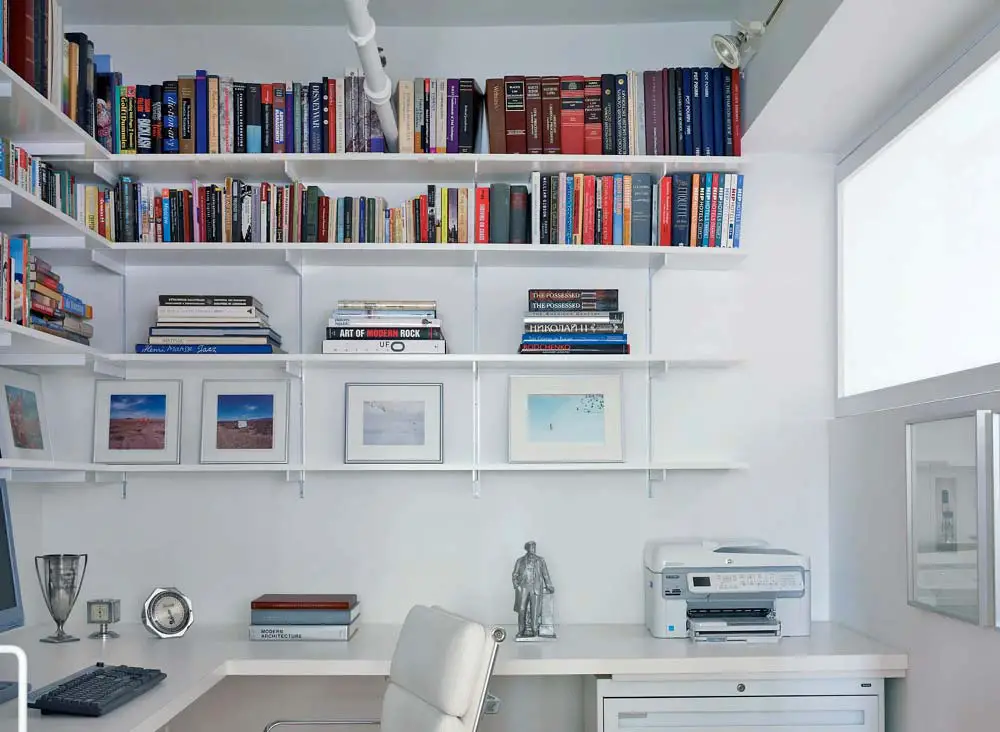
Image credit: architecturaldigest.com
Effective storage keeps your workspace organised and clutter-free. Floating shelves are perfect for small offices as they provide additional storage without taking up valuable floor space. They are ideal for storing books, office supplies, or decorative items.
I also suggest considering storage boxes and organisers that can fit neatly under your desk or on shelves. These can help keep smaller items, like stationery and materials tidy. A vertical filing cabinet can also save space while offering substantial storage for documents and other paperwork.
As mentioned previously, compact desks with built-in storage such as drawers or cabinets also offer a practical solution for keeping essentials within arm’s reach, creating a tidy and efficient work space.
Innovative Seats for Comfort and Style
Choosing the right chair is essential for both comfort and productivity, especially if you are going to be working long hours. An ergonomic desk chair with adjustable height, lumbar support, and breathable materials is a must have.
For added style without sacrificing function, look for chairs that swivel or pivot. This can make it easier to move around your workspace. Alternatively, stools or small, compact chairs can be tucked away when not in use, making them a practical choice for tiny offices.
Antique secretary chairs can also add a touch of character while often being smaller than modern office chairs. Combining form and function, these options ensure that seating in your small home office remains both comfortable and visually appealing.
Lighting and Visibility

Image credit: futuristarchitecture.com
Good lighting is essential for a productive and comfortable home office, whether big or small. Both natural light and artificial lighting play key roles in achieving the right balance.
Optimising Natural Light
I always start by evaluating the natural light in any space that I am designing. Large windows and skylights are great for flooding a room with sunlight, reducing the need for artificial lighting during the day. Positioning your desk near a window allows you to benefit from all of this natural light, which can boost your general mood and focus.
To control glare, I like to use adjustable blinds or curtains. This helps maintain visibility without straining my eyes. If your home office doesn’t have large windows, I suggest using light-coloured walls and reflective surfaces to maximise the natural light available.
Artificial Lighting Options
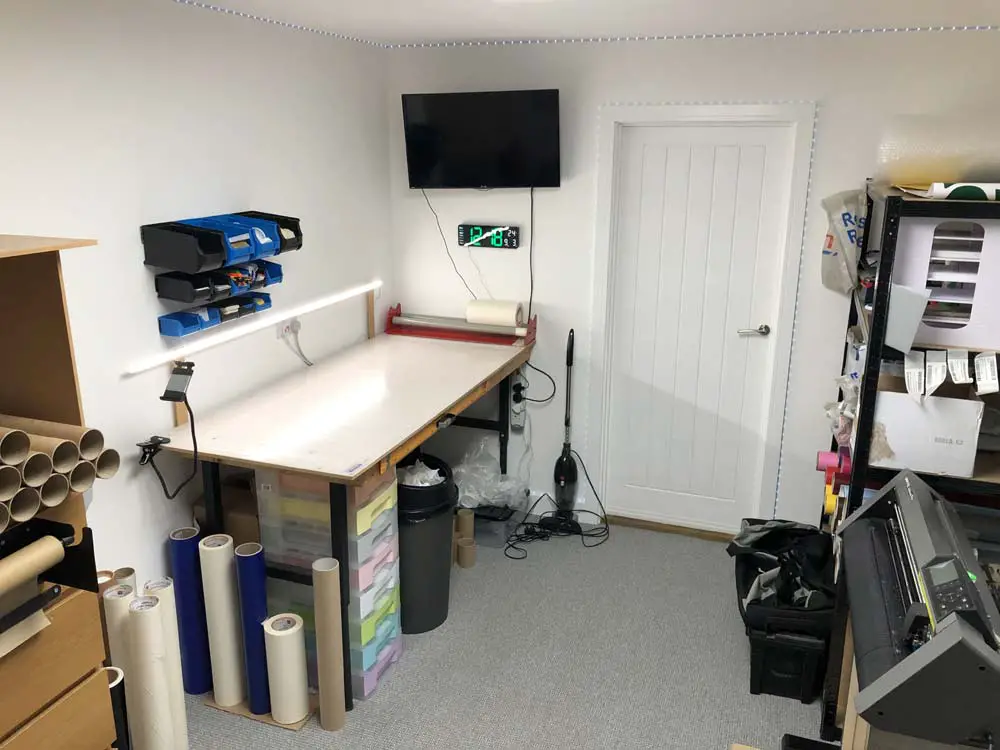
In my own garage office workspace, shown above, I use a combination of task and ambient lighting to keep my office well-lit. Task lighting, like the LED strip that I use above my workbench illuminates my work area, making it easier to see what I am doing when manufacturing wall stickers.
Ambient lighting fills the rest of the room, with the use of a large LED panel ceiling light. I have also added colour-changing LED lights around the top of my walls for extra light and for the ability to change the mood when I feel the need.
As a tip, I suggest that you avoid relying solely on overhead lights as they can create shadows and uneven lighting. Using a mix of light sources ensures even illumination and reduces eye strain.
Decorative Elements and Personal Touches
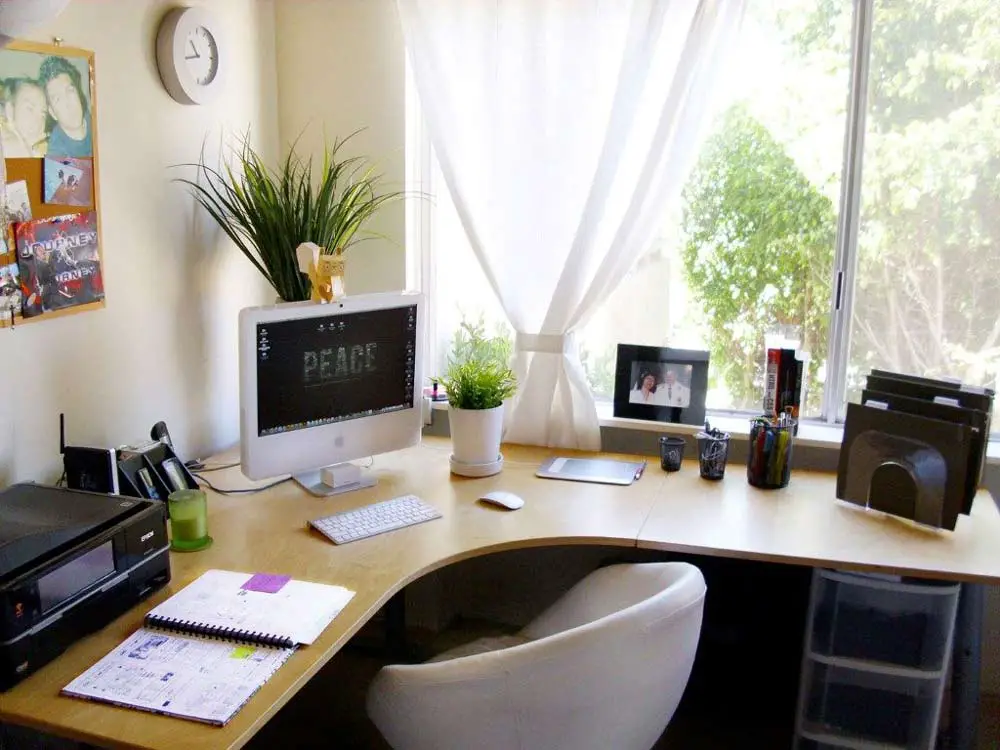
Image credit: startupguys.net
Adding decorative elements and personal touches will make any home office more inviting and comfortable. Incorporating items like art, plants, and other interesting decor can transform your small workspace into a productive and inspiring environment.
Art and Photography for Inspiration
Wall art and photographs can have a significant impact on your mood and creativity while at work. I recommend creating a small gallery wall with your favourite pieces. This can be a mix of paintings, prints, and photographs. Including images that inspire you or reflect your interests can boost your motivation.
Consider placing a few choice pieces at eye level where you can easily see them while working. Even in a small space, rotating a few artworks every few months can keep your home office feeling fresh.
Accessorising with Plants and Flowers
Plants and flowers add life and colour to any space and ultimately make it feel more homely. In a small home office, even a few well-placed plants can make a big difference. I find that succulents, ferns, and small potted plants work best as they don't require much maintenance and thrive indoors.
Grouping plants or flowers in decorative pots or vases can create a charming, cohesive look. A more modern touch can be created by selecting sleek, stylish containers.
Unique Wall Decor Ideas
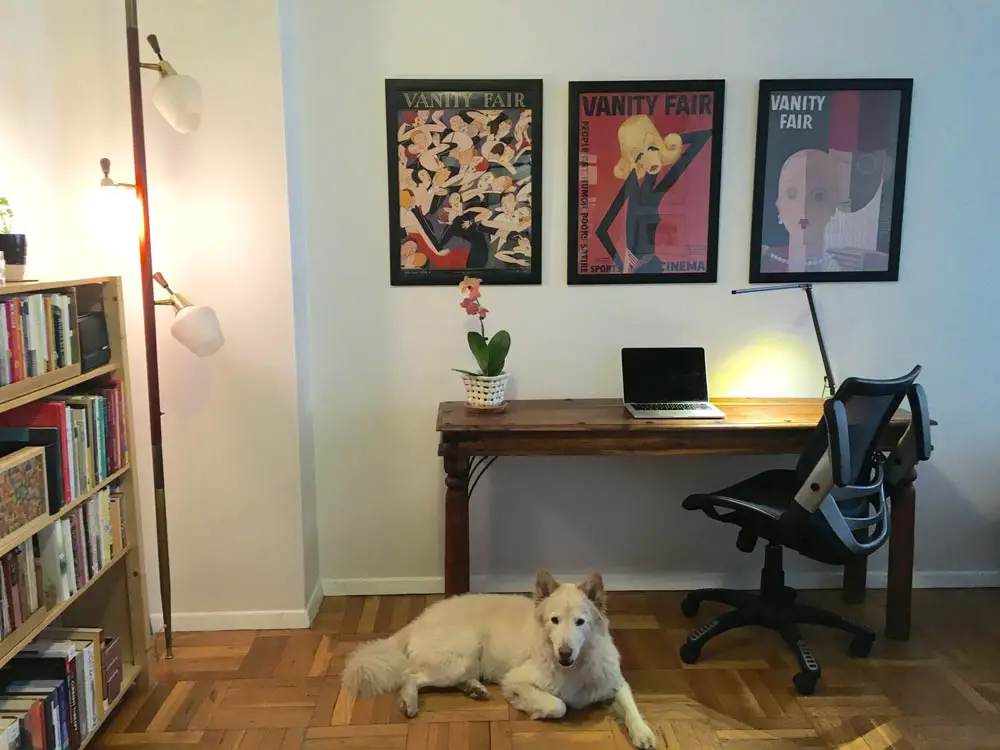
Image credit: savemycents.com
Making the most of your wall space is key in a small office. Think outside the box and use items that reflect your personal style. Hanging shelves can hold books, collections, or decorations without taking up floor space, or consider using hooks or pegs for functional and decorative items like plants, stationary, or other practical materials.
Incorporating wallpaper or decals can also add interest to your office space without overwhelming it. For a unique touch, use chalkboard paint on a section of the wall. This provides a multifunctional surface where you can jot down notes, ideas, or even doodles. Decorating your home office walls creatively can help make the space feel more personal and engaging.
Smart Productivity Hacks
In a smaller space, an efficient home office setup and layout and managing technology can make all the difference. These strategies aim to boost productivity while keeping the workspace clutter-free.
Efficient Layouts and Organisation
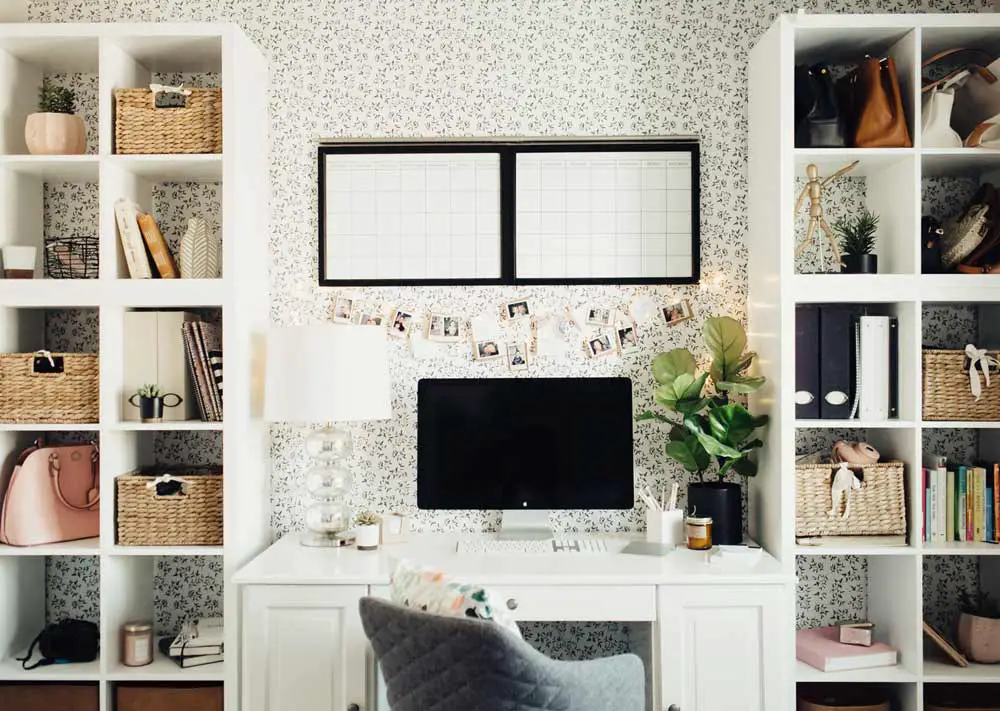
Image credit: littlemissfearless.com
The layout of your small home office should make the most of the available space while allowing for easy movement and access to essentials.
Vertical Storage is a game-changer. By using wall-mounted shelves and cabinets, you can save desk space and keep frequently accessed items within easy reach. Floating shelves are particularly useful as they add storage without taking up floor space.
Multi-purpose furniture like desks with built-in storage or fold-out desks can also be highly effective. These pieces combine functionality with efficient use of space, making them ideal for a small home office.
Decluttering is also crucial as far as I'm concerned. Keep only what you need on your desk. Use drawer organisers and desktop trays to store stationery and other small items. A clutter-free space helps in maintaining focus and reducing distractions.
Managing Technology and Cords
Handling technology and cord management efficiently is another essential piece of the puzzle in any small workspace.
Good cord Management can significantly reduce visual clutter. Use cable organisers such as cord clips, zip ties, and cable sleeves to keep wires neat. An organised system not only looks better but also makes it easier to unplug devices without disrupting the whole setup.
Wireless Devices can limit the number of cords running across your desk. Consider investing in a wireless keyboard, mouse, and printer. This reduces the tangle of wires and allows for greater flexibility in your workstation layout.
Docking Stations can also be very useful. They centralise your peripherals in one location, which can simplify your workspace and reduce cord chaos. By plugging all devices into a docking station, you only need one cord to connect everything to your computer.
Colour Schemes that Inspire
Finding the right home office colour scheme can greatly impact your productivity and mood. Here are some ideas for selecting a palette and understanding how colours influence your work environment.
Selecting a Palette for Your Workspace
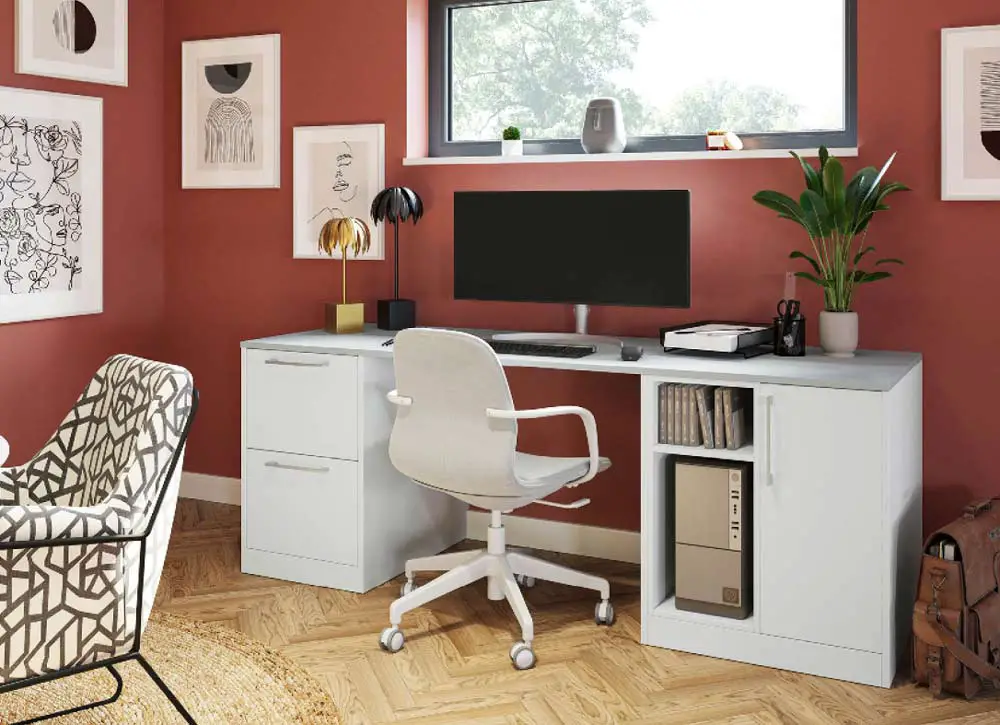
Image credit: crown-imperial.co.uk
In a small home office, light colours can make the space feel larger and more open. Whites and beiges are classic choices. If you want a bit of colour though, pastel shades like light blue or soft green work well.
If you prefer something bolder, try a feature wall with patterns or even a bold wallpaper. Floral or geometric designs can add a touch of interest and design to your workspace.
Boho-style enthusiasts might enjoy a mix of natural tones with vibrant accents. On the other hand, if a soothing colour palette is your aim, shades like sage green or pale grey offer a calming effect.
My personal preference is to use colours that either match the rest of the home's style and design, or painting the walls in a way that makes the space look and feel bigger. For the later, opt for colours that enhance natural light to keep the area bright and lively, such as whites and creams.
How Colours Affect Mood and Focus
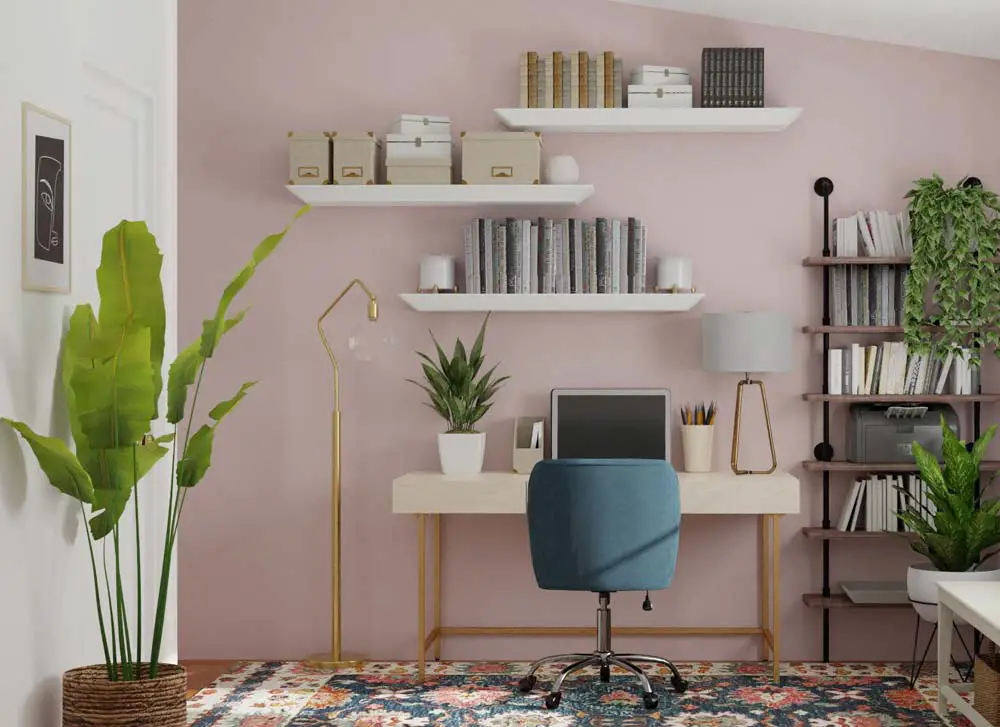
Image credit: spacejoy.com
Different colours can change the way you feel and work. For instance, blue is known to be a calming colour, making it perfect for reducing stress. A light blue can create a feeling of serenity and focus, while a darker blue can add a touch of elegance.
Green is another excellent choice as it’s easy on the eyes and evokes a sense of nature. This could be a bold green like Sherwin-Williams' Rosemary, or a softer beige green for a more neutral background.
Yellow can boost energy and creativity but should be used sparingly to avoid overwhelming the senses. If you enjoy a more dreamy or shabby chic atmosphere, consider soft pinks or gentle lavender.
In a Boho-style office, rich, earthy colours combined with lighter hues can create a vibrant yet balanced environment. Don’t underestimate the power of colour psychology in making your workspace both functional and inspiring.
The Practicalities of a Home Office
A well-organised home office blends comfort, efficiency, and health considerations to create a productive work environment.
Ergonomic Considerations for Health
Creating a healthy workspace is crucial. The right chair is essential. I prefer a comfortable chair with good lumbar support. This supports the lower back and can prevent pain during long hours at the desk. A cushion offers additional comfort if needed.
A laptop stand or adjustable desk setup keeps the screen at eye level, reducing neck strain. I recommend a chair with a swivel function for easy movement and access to various parts of my workspace without unnecessary strain.
Finally, regular breaks to stretch and move around are necessary. Sitting in one place for a long time can lead to health issues, so I set reminders to take short breaks.
Creative Space-Saving Solutions
Maximising a small home office requires clever design. Whether you're customising your area with DIY projects or investing in multi-functional furniture, these solutions can transform even the tiniest of spaces.
DIY Projects to Customise Your Area

Image credit: clare.com
Creating a floating desk can free up floor space and give a sleek look to your office. You could craft it using plywood or an old door, then mount it on brackets. Adding shelves above keeps your essentials within reach and the desk clear.
A 'cloffice' is another great idea. Simply transform a closet or understairs cupboard into a small office by adding a desk and shelves inside. This makes use of often overlooked space while keeping your work area neat and hidden when not in use.
Building a corner desk can help you optimise tight or awkward spaces. Fit it snugly into any corner for an instant productivity hub. It can be as simple as two boards joined to form an L-shape and supported by legs or brackets.
Multi-Functional Furniture
Investing in wall-mounted desks can save space and create a minimalistic look. These desks fold down for use and fold back up when you're done, freeing up valuable floor area. Some even come with built-in storage.
A vanity that doubles as a desk can be an elegant solution. Look for styles with enough surface area for work items and integrated drawers or shelves to store office supplies.
Convertible furniture like a fold-out table or a murphy bed with a built-in desk can transform your room from work to relaxation mode instantly. This dual-purpose approach is perfect for making the most of every square inch.
Another solution is to use storage ottomans or benches that serve as seating, as they can hide away items like files or office supplies. This keeps your workspace tidy and stylish.
Accessorising for Productive Ambience
Creating a stylish and cosy atmosphere in a small home office involves careful selection of accessories like rugs, curtains, and mirrors. These items can make a big difference in the look and feel of your workspace.
Choosing the Right Rugs and Curtains
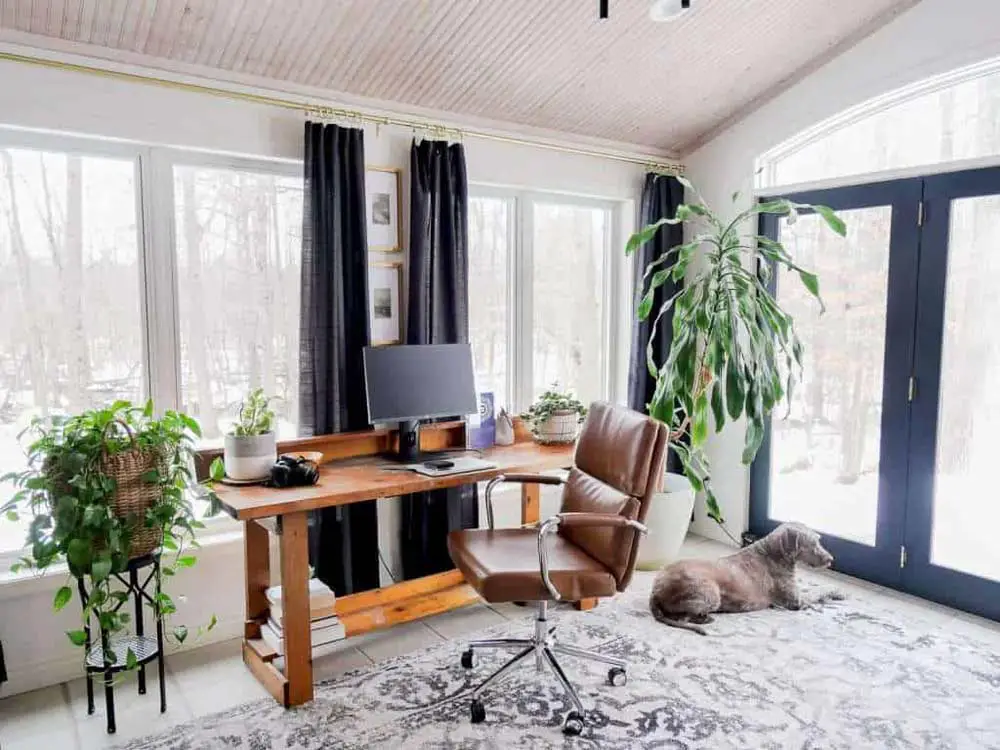
Image credit: graceinmyspace.com
Rugs can define your workspace and add comfort underfoot. In an office space, I look for rugs that are not too large, ensuring they fit well in the space without dominating it. A bold pattern can add personality, while neutral tones can create a calm environment. It's essential to choose a rug that is easy to clean, especially if you expect a lot of foot traffic or if you have pets.
Curtains play a crucial role in controlling light whilst also adding style. Lightweight curtains allow natural light to filter through, reducing glare on screens while maintaining brightness. Thicker, darker curtains can be used if you need more privacy or to block out light for better focus. I often recommend curtains with a simple design that complements the rest of the office decor without being too distracting.
Enhancing Space with Mirrors
Mirrors are great for creating an illusion of space. In a small home office, placing a mirror opposite a window can reflect natural light, making the room feel larger and brighter. A decorative mirror also adds a touch of elegance and can serve as a focal point. I recommend choosing a mirror with a frame that matches the office aesthetic to keep a cohesive look, but it really is personal preference.
Incorporating Lifestyle and Entertainment
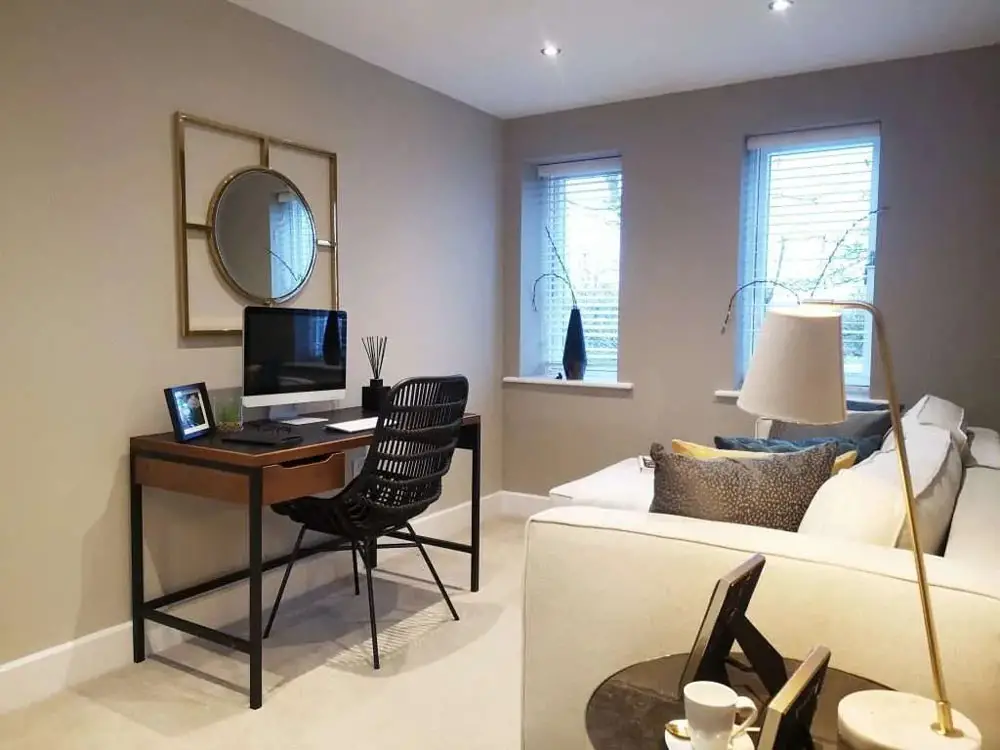
Image credit: backhousehousing.com
Creating a small home office that blends work with leisure can improve productivity and make your space feel more enjoyable. By thoughtfully integrating elements like entertainment and aesthetics, you can construct a balanced and inspiring environment.
Balancing Work with Leisure
It's essential to create a retreat-like atmosphere in your small home office. Adding a TV can help you take short breaks and stay current with news or TV shows. However, ensure it doesn't detract from your work focus by placing it where it’s not directly in your line of sight.
Consider incorporating elements like photos or artwork, these can personalise your space and make it more inviting. Whether it's a framed picture of family, or a beautiful landscape, these touches offer visual relaxation.
Creating an environment surrounded by things you enjoy makes your office feel less rigid and more comfortable. Balance, comfort, and deliberate design choices can turn even the smallest space into a versatile and productive work area.
Final Touches for a Professional Feel
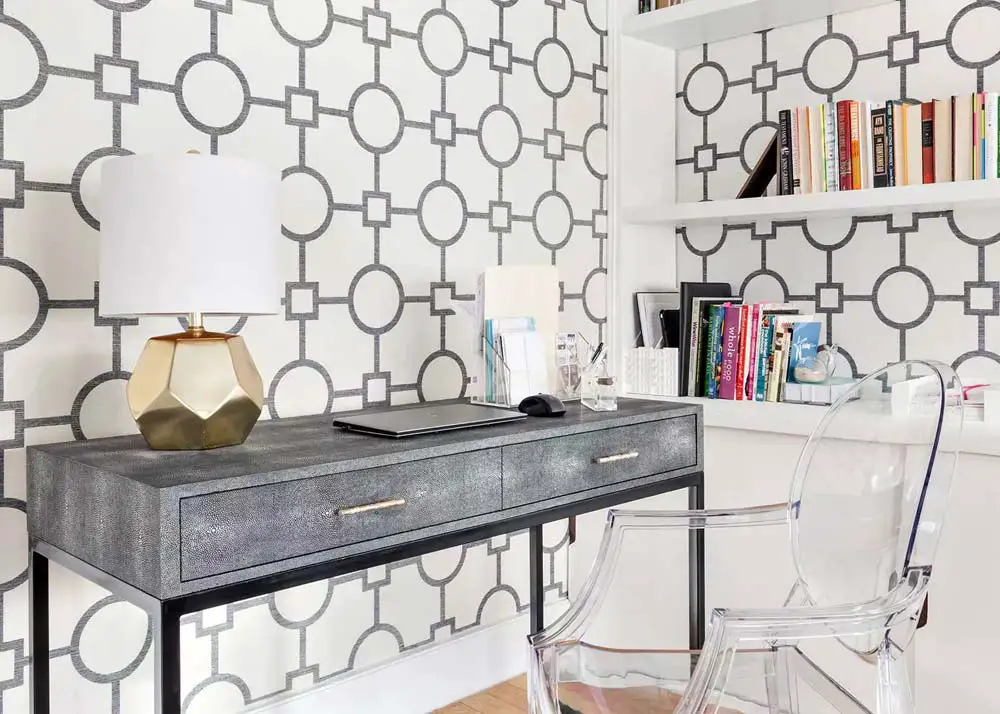
Image credit: holmesstclair.com
Making any home office look professional involves optimising surface space for organisation and managing appearances during video calls.
Surface Space and Organisation
Surface space is key in a small home office. I find a clean and organised desk makes me more productive and motivated to work. Using drawers and shelves can help. Adding a label to drawers and boxes makes it easy to find what I need. A wall of books can also create a professional and intellectual look, if that helps the image of your business.
I also like to use vertical space to it's fullest. Wall-mounted organisers and pegboards keep items well-organised and off the desk. I also prefer using multi-functional furniture wherever possible. A desk with built-in storage is a lifesaver for any small space. Opting for a minimalist desk helps, too as It gives a sense of calm and focus.
Managing Appearances in Video Calls
If you work for an organisation, video calls are a big part of working from home, so having a good background is crucial. If you have one, sitting in front of a window is a bonus, as the natural light can enhance both the light and your appearance. For more privacy though, use a plain wall or a wall of books as a backdrop. This makes the space look tidy and professional.
If you don't have the benefit of natural light, other lighting solutions are even more vital for video calls. This can be remedied by using a ring light or desk lamp to improve the ambient light quality. I would avoid sitting where there are stripes or busy patterns, as they can be distracting. Keeping the background uncluttered will certainly help make a good impression.



 Author: Matthew Chiappini
Author: Matthew Chiappini